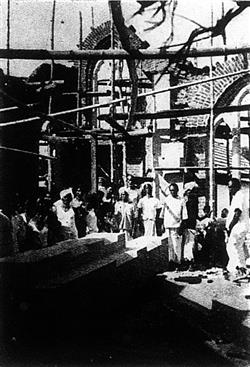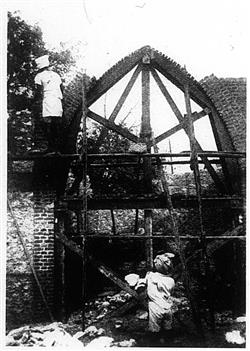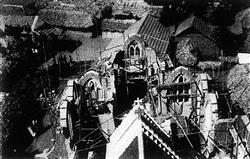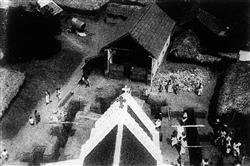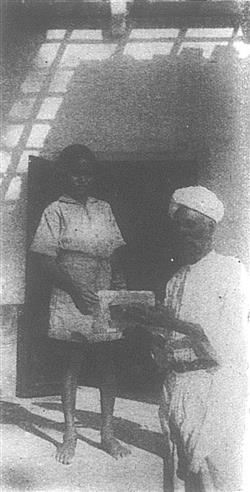SCHOOLBOY BUILDERS
THE ART INDUSTRIAL SCHOOL, NAZARETH
Extracts FROM A REPORT SENT BY THE REV. G. E. HUBBARD, MISSIONARY AT
NAZARETH, TINNEVELLY, SOUTH INDIA
May 1939
The half-year now ended has been a happy time, very fully occupied. The Art Industrial School is taking in many more building contracts than it normally did in my predecessor's time, the reason being that our carpentry goods are not wanted to the same extent as, say, ten years ago. High-class furniture is in less demand; it is expensive, and though Europeans can buy it, they are now being replaced by Indians in every department, and the average Indian does not want highly finished furniture. The lower level of carpentry orders is at present amply compensated for by the woodwork orders involved in the building contracts, for my system is to prepare plans free of cost on condition that all woodwork goes to the A.I.S. The trouble is that while carpentry orders can be repeated, woodwork orders in buildings "stay put."
There are five sets of building works going on in the immediate neighbourhood of Nazareth under these conditions.
OYANGUDI CHURCH
Excellent progress has been made with the rebuilding of this church. I am making a complete break with the so-called Christian (i.e. Gothic) architecture imported into the country by the pioneer missionaries. Instead I am using the architecture of the country.
A TWENTY-TON MONOLITH
The columns are great monoliths, hewn out of the slopes of the nearby Travancore mountains, and worked up by Hindu masons along the lines of the beautiful columns to be found in all the temples of Southern India. The smaller columns were brought to the site from the quarries by bullock carts, groaning and creaking along the rough country roads. The great 20 ton monoliths were brought to Nazareth station, and thence dragged for nearly four miles on rollers and metal sheeting, by scores of willing workers from the village.
It is all intensely interesting. One is living again in mediaeval times when the village church was being built. The old grannies on their doorsteps give me an enthusiastic welcome whenever I go over to see the building. They love to see their own architecture appearing in their own village church. I am quite sure that there is a spiritual value to be obtained by using local architecture. A non-Christian would feel more at home at once in a building which is of his country than in one of foreign design.
GIRLS' SCHOOL CHAPEL, NAZARETH
The chapel for the St. John's High School was completed early in November. The accompanying picture shows the chancel arch being built. The wood centering was quite new to the Nazareth masons and caused much interest. It was constructed in sections by the senior boys, who also assembled and dismantled it. The building was dedicated on November 4, 1938. Everything inside the chapel (except the harmonium) was made by the A.I.S. - even the floor tiles were ordered, laid and polished by the boys.
BUILDING THE CHANCEL ARCH FOR THE CHAPEL AT NAZARETH
Reinforced concrete has been extensively used, as it is a safe, cheap and satisfactory medium. I was able to keep down the cost of the chapel to less than £310—the cost of a cheap bungalow in England.
Mr. Hubbard then mentions the other buildings upon which the A.I.S. has been engaged: a Co-operative Bank in Nazareth, the repair of the A.I.S. bungalow, and (most important of all, though not yet far advanced) the new chapel for the Theological College.
OYANGUDI CHURCH: PREPARING THE FOUNDATIONS
OYANGUDI CHURCH: THE WALLS GO UP
THE BUILDERS
The health of the school is excellent. Good food and hard work produce the fitness which is such a characteristic of the A.I.S. boys. A few weeks ago I had a case of infectious leprosy in a junior boy. His chief symptoms were apparent chronic malnutrition and a sore on his nose. The disease was discovered through the boy's reporting sick with quite a minor complaint. I at once sent him to a Government Leper Institution, the nearest to Nazareth. Another is being treated for epilepsy, though I am not treating him as an invalid in any way.
I have now twenty-six boys ready for Confirmation, and eighteen for Baptism. My little protégé, whom I call Tumpee, has recently lost his mother, and his father is a drunkard. The little fellow is bright and intelligent, and is at work in the tailoring section of the A.I.S. He is great friends with my old butler, Moses, and the old man wants me to take on the little boy as his assistant.
The School Anniversary was marked by Festal Evensong on November 3, and a Choral Celebration the next morning. At both services staff, wives and families turned up in force. A special mid-day feast was followed by two days' home holiday to boys living near, and no work to the others who live at a distance. After all, the dhurrie (as I am called) is not such a hard man as some people still think.
I am continuing to act as visiting chaplain of the English church at Madura, and go over at least once a month. The visits make pleasant breaks in the midst of all the very technical work I am called upon to carry out as principal of the A.I.S. They serve to remind me that bricks and mortar are not the things which matter most …
We are passing through difficult times, and I shall greatly value the prayers of those who may read this report, that I may be given wisdom in guiding the affairs of the A.I.S.; so that whatever may happen to the school in the future (it may be handed over to Indian management when I go), everything may be for the best and to the glory of God.
TUMPEE AND MOSES
